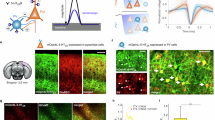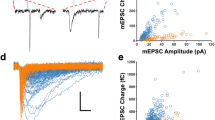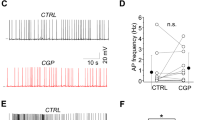Abstract
replying to S.-H. Lee, A. C. Kwan & Y. Dan Nature508,http://dx.doi.org/10.1038/nature13128(2014)
Several recent studies have examined the function of parvalbumin-expressing (PV+) and somatostatin-expressing (SST+) inhibitory neurons in V1 (refs 1, 2, 3). Although it is commonly agreed that these cell types alter the responses of pyramidal neurons in distinct ways—via divisive or subtractive inhibition—their specific roles remain a matter of debate. The Comment by Lee et al.4 presents new data suggesting that the differences between the results of Lee et al.2 compared to Atallah et al.3 and Wilson et al.1 could be explained by the strength and duration of laser stimulation used to optogenetically activate these two classes of inhibitory neuron. The data presented by Lee et al.4 now clarify that PV+ neurons, when probed with small amounts of optogenetic activation, do not significantly change the tuning of their target cells, confirming Atallah et al.3 and Wilson et al.1. The new SST+ results presented in the Comment4 show that SST+ neurons can subtract responses, consistent with Wilson et al.1, but we suggest that the switch of function of SST+ neurons in their data between short (1 s) and long (4–5 s) stimulation reveals a core principle of inhibition in cortical networks rather than simply being a peculiarity of stimulation protocols. The fundamental difference between these two conditions resides in the temporal overlap between inhibitory neuron activation and target-cell responses: when these overlap, inhibition is divisive (causing no change in tuning width of target neurons), but when they do not overlap, inhibition is subtractive (and reduces tuning width).
This is a preview of subscription content, access via your institution
Access options
Subscription info for Japanese customers
We have a dedicated website for our Japanese customers. Please go to natureasia.com to subscribe to this journal.
Buy this article
- Purchase on SpringerLink
- Instant access to full article PDF
Prices may be subject to local taxes which are calculated during checkout
Similar content being viewed by others
References
Wilson, N. R., Runyan, C. A., Wang, F. L. & Sur, M. Division and subtraction by distinct cortical inhibitory networks in vivo. Nature 488, 343–348 (2012)
Lee, S.-H. et al. Activation of specific interneurons improves V1 feature selectivity and visual perception. Nature 488, 379–383 (2012)
Atallah, B. V., Bruns, W., Carandini, M. & Scanziani, M. Parvalbumin-expressing interneurons linearly transform cortical responses to visual stimuli. Neuron 73, 159–170 (2012)
Lee, S.-H., Kwan, A. C. & Dan, Y. Interneuron subtypes and orientation tuning. Nature 508, http://dx.doi.org/10.1038/nature13128 (2014)
Ma, W. et al. Visual representations by cortical somatostatin inhibitory neurons—selective but with weak and delayed responses. J. Neurosci. 30, 14371–14379 (2010)
Adesnik, H., Bruns, W., Taniguchi, H., Huang, Z. J. & Scanziani, M. A neural circuit for spatial summation in visual cortex. Nature 490, 226–231 (2012)
Gentet, L. J. et al. Unique functional properties of somatostatin-expressing GABAergic neurons in mouse barrel cortex. Nature Neurosci. 15, 607–612 (2012)
Pfeffer, C. K., Xue, M., He, M., Huang, Z. J. & Scanziani, M. Inhibition of inhibition in visual cortex: the logic of connections between molecularly distinct interneurons. Nature Neurosci. 16, 1068–1076 (2013)
Brunel, N. & Hakim, V. Fast global oscillations in networks of integrate-and-fire neurons with low firing rates. Neural Comput. 11, 1621–1671 (1999)
Author information
Authors and Affiliations
Contributions
S.E.-B. did additional experiments, and S.E.-B. and M.S. wrote the response with contributions from N.R.W. and C.A.R.
Corresponding author
PowerPoint slides
Rights and permissions
About this article
Cite this article
El-Boustani, S., Wilson, N., Runyan, C. et al. El-Boustani et al. reply. Nature 508, E3–E4 (2014). https://doi.org/10.1038/nature13130
Published:
Issue Date:
DOI: https://doi.org/10.1038/nature13130
This article is cited by
-
Inhibitory stabilization and cortical computation
Nature Reviews Neuroscience (2021)
-
Somatostatin cells regulate sensory response fidelity via subtractive inhibition in olfactory cortex
Nature Neuroscience (2015)
-
Response-dependent dynamics of cell-specific inhibition in cortical networks in vivo
Nature Communications (2014)




